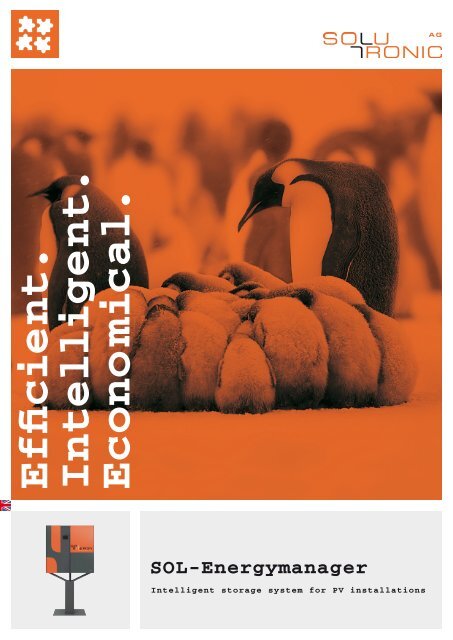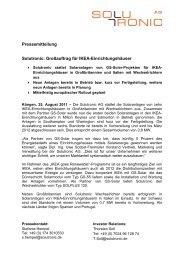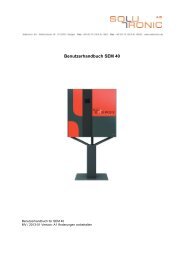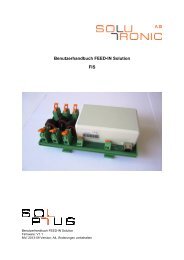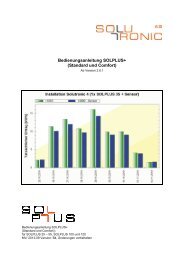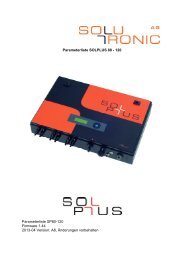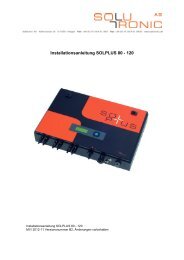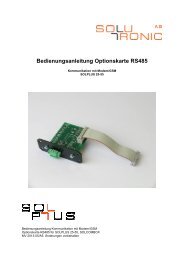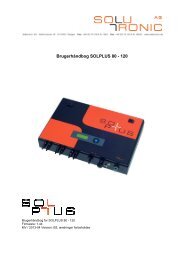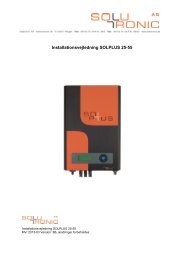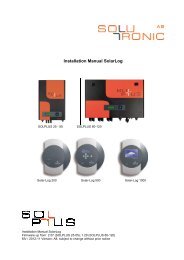SOL-Energymanager
SOL-Energymanager
SOL-Energymanager
Create successful ePaper yourself
Turn your PDF publications into a flip-book with our unique Google optimized e-Paper software.
Efficient.<br />
Intelligent.<br />
Economical.<br />
<strong>SOL</strong>-<strong>Energymanager</strong><br />
Intelligent storage system for PV installations
<strong>SOL</strong>-<strong>Energymanager</strong><br />
One of the challenges faced in<br />
the effort to expand the use of<br />
renewable energy sources is to<br />
find a solution to the problem<br />
of decentralised storage and<br />
intelligent management of solar<br />
energy. The energy generated by<br />
the photovoltaic modules on the<br />
roof also needs to be available<br />
at times when the sun isn’t<br />
providing the energy required to<br />
generate electricity. This is where<br />
the <strong>SOL</strong>-<strong>Energymanager</strong> comes<br />
in – a mini solar power plant<br />
comprising a PV inverter, battery<br />
inverter, energy management<br />
system and Li-ion battery. The<br />
purpose of the <strong>SOL</strong>-<strong>Energymanager</strong><br />
is to source as little electricity<br />
from the grid as possible<br />
and to maximise the amount of<br />
self-generated power consumed.<br />
It’s designed and configured to<br />
give the end customer maximum<br />
economy.<br />
Subject to change without notice. Errors excepted.<br />
<strong>SOL</strong>-<strong>Energymanager</strong><br />
Customers are supplied with a<br />
compact, single-unit system. No<br />
complex, standalone pieces of<br />
equipment are necessary. The<br />
unit is ready to use immediately<br />
after installation. The system is<br />
connected to the electricity<br />
system of the building by means<br />
of a meter box integrated into<br />
the cabinet, and it manages<br />
in-house consumption fully automatically.<br />
There‘s no need for the<br />
owner to carry out any manual<br />
adjustments.<br />
Energy flow directions<br />
Viewed in its pure form, energy<br />
flows in different directions in the<br />
<strong>SOL</strong>-<strong>Energymanager</strong> system.<br />
• PV ➞ electrical consumers:<br />
the PV current supplies the<br />
electrical consumers directly.<br />
• PV ➞ grid: the energy generated<br />
by the solar generator is<br />
fed into the grid.<br />
Terminal box for fuses and service connections<br />
Touchdisplay<br />
Battery<br />
Energy management control unit<br />
Solar inverter (behind enclosure)<br />
Battery management<br />
• PV ➞ battery: the energy generated<br />
by the solar generator is<br />
fed to the battery.<br />
• Battery ➞ electrical consumers:<br />
the consumers are<br />
supplied with power from the<br />
battery.<br />
• Grid ➞ electrical consumers:<br />
the consumers are supplied<br />
with power from the grid.<br />
• Battery ➞ grid: the battery<br />
feeds energy into the grid.*<br />
• Grid ➞ battery: energy from<br />
the grid is used to charge the<br />
battery.*<br />
* Owing to our goal of<br />
achieving optimum usage of selfgenerated<br />
power, these energy<br />
flow directions are currently not<br />
provided for.<br />
In reality, it‘s more of a mixture<br />
of these modes, depending on<br />
the direction selected for the<br />
flow of energy and the availability<br />
and amount of electricity required<br />
in the building. In keeping with<br />
the aim of increasing the amount<br />
of self-generated energy consumed<br />
in-house, the system gives<br />
priority to supplying the in-house<br />
consumers over feeding power<br />
to the grid.<br />
If we look at the battery‘s state<br />
of charge, the following statuses<br />
are possible depending on the<br />
size of the consumer and the<br />
level of insolation:<br />
Battery fully charged:<br />
• Power goes to the consumers<br />
• Excess power is fed into the<br />
grid<br />
Battery not fully charged: (depending<br />
on the level of insolation)<br />
• Power goes to the consumers<br />
• Excess power is fed to the<br />
battery
Battery efficiency and<br />
capacity utilisation<br />
The efficiency of the battery depends<br />
on the battery‘s own internal<br />
resistance. This is influenced<br />
not only by the state of charge<br />
and „state of health“ of the battery,<br />
but also by its temperature.To<br />
optimise the battery‘s efficiency<br />
and its longevity, it’s utilised to<br />
max. 80% of its charge capacity<br />
and its power output (for supplying<br />
the electrical consumers) is<br />
limited to max. 1500 W. Outputs<br />
higher than 1500 W are always<br />
supplemented by drawing power<br />
from the mains. In this way, we<br />
achieve battery charging efficiency<br />
(charging and discharging)<br />
of 97% (including cell losses and<br />
contact resistance).<br />
System efficiency = nighttime<br />
efficiency<br />
The energy generated by the<br />
solar generator is fed to the<br />
String 1<br />
String 2<br />
DC<br />
circuit<br />
breaker<br />
battery during the day and then<br />
transferred to the power system<br />
or to the electrical consumers,<br />
later (during the night).<br />
In this system, the DC/DC<br />
converter of the solar inverter<br />
achieves 99% efficiency. The solar<br />
inverter itself is up to 98.1%<br />
efficient. The electrically isolated<br />
battery DC/DC converter reaches<br />
peak efficiency figures of up to<br />
98.2%. All in all, the full storage<br />
process (from the PV generator<br />
to the battery and into the grid)<br />
chalks up an overall nighttime<br />
efficiency rating of 90.8%.<br />
To further optimise the system<br />
as a whole, care has been taken<br />
when designing the enclosure to<br />
ensure that the waste heat from<br />
the battery does not dissipate in<br />
the direction of the inverters, so<br />
that they remain as cool as possible.<br />
Moreover, the <strong>SOL</strong>-<strong>Energymanager</strong><br />
also achieves excellent<br />
levels of efficiency at the low<br />
DC/DC<br />
converter<br />
controller<br />
Subject to change without notice. Errors excepted.<br />
Emperor penguin<br />
Efficient, intelligent and with staying power.<br />
The emperor penguin is a master of energy<br />
management. Its plumage provides insulation,<br />
its subdermal fat acts as an energy store and<br />
its limbs as heat exchangers. To protect themselves<br />
against the cold, a colony of emperor<br />
penguins forms a compact huddle that slowly<br />
‚churns‘ around the edge of the formation,<br />
ensuring that each bird enjoys a period of<br />
protection on the inside of the throng. All<br />
are key characteristics for ensuring optimum<br />
utilisation of the energy available.<br />
DC/DC converter<br />
Li-ion<br />
modules<br />
end of its output range when providing<br />
electricity at night, even<br />
though it has to operate below<br />
its rated output point.<br />
The <strong>SOL</strong>-Energymanger is based<br />
on the system of a central, intermediate<br />
DC link. This offers the<br />
following advantages:<br />
• a compact unit thanks to a<br />
compact enclosure (weight/<br />
size)<br />
• a central control unit<br />
• no need for a redundant DC/<br />
AC inverter<br />
• maximum efficiency<br />
Battery size and design<br />
The <strong>SOL</strong>-<strong>Energymanager</strong> is a<br />
system designed specifically for<br />
households with an annual electricity<br />
consumption of up to 6000<br />
kWh. Panels with a combined<br />
maximum DC output of 4800 W<br />
can be connected to the solar<br />
inverter that comes with the<br />
PV inverter controller<br />
Connection for<br />
additional inverters<br />
Appliance controller<br />
AFI<br />
Inverter<br />
Local<br />
visualisation &<br />
control<br />
Ethernet<br />
Production<br />
meter<br />
Power<br />
meter<br />
system, which means even small<br />
roofs are suitable. The design<br />
target when dimensioning the<br />
battery storage capacity (taking<br />
into account annual consumption)<br />
is to see between 90 and 100%<br />
of self-generated electricity consumed<br />
during the months from<br />
spring to autumn. At wintertime,<br />
the battery principally serves to<br />
cover daytime power consumption.<br />
The battery can, however,<br />
also be used as kind of ‘night<br />
storage power supply’, being<br />
charged with off-peak electricity<br />
for use during the next day.<br />
The size of battery required to<br />
provide the maximum possible<br />
in-house consumption depends<br />
on the household’s load profile:<br />
at what times of day are the inhabitants<br />
at home, what electrical<br />
loads are in use and whether they<br />
can be controlled, and how high<br />
the annual power consumption is?<br />
Emergency<br />
power<br />
relay<br />
Existing<br />
electrical<br />
installation of<br />
building<br />
Purchasedenergy<br />
meter and<br />
export<br />
meter<br />
Building<br />
automation<br />
interface<br />
Grid
<strong>SOL</strong>-<strong>Energymanager</strong><br />
The bar chart (fig. 1) shows how<br />
to calculate the size of battery<br />
required for three different<br />
types of consumer, based on<br />
their annual consumption. These<br />
calculations were made on the<br />
assumption that the battery holds<br />
it charge throughout the night in<br />
spring and autumn.<br />
Provided there is a certain level<br />
of daily consumption (that “matches”<br />
the insolation profile), a<br />
5.4-kWh battery fits the bill in the<br />
majority of cases – which is the<br />
size supplied with the standard<br />
configuration of the system. We<br />
will be offering an optional add-on<br />
comprising one or two additional<br />
storage modules, each with a<br />
capacity of 1.7 kWh.<br />
Figure 1<br />
8<br />
7<br />
6<br />
5<br />
4<br />
Annual<br />
consumption<br />
Battery size in kWh<br />
5.4 4.4 3.6 7.2 5.4 4.4 9.0 7.2 5.4<br />
4000 kWh 5000 kWh 6000 kWh<br />
almost never<br />
at home<br />
some at<br />
work<br />
Subject to change without notice. Errors excepted.<br />
Communication concept<br />
The various components that<br />
make up the <strong>SOL</strong>-<strong>Energymanager</strong><br />
system communicate with each<br />
other via serial ports. Customers<br />
can read out all the relevant data<br />
regarding insolation, in-house<br />
consumption and battery charge<br />
level on the integral touchscreen.<br />
And if the <strong>SOL</strong>-<strong>Energymanager</strong><br />
is connected to the internet, its<br />
data can also be accessed remotely<br />
using a PC or smartphone.<br />
(fig. 2)<br />
family with<br />
children<br />
PV module<br />
Safety<br />
Device, customer and installation<br />
safety are key criteria for the<br />
<strong>SOL</strong>-<strong>Energymanager</strong>. Each and<br />
every component of the system<br />
has been tested and approved.<br />
The inverter conforms to the<br />
relevant VDE standard and the<br />
battery unit offers maximum<br />
safety by means of electrical<br />
isolation.<br />
<strong>SOL</strong>-<strong>Energymanager</strong><br />
Brief data sheet<br />
Max. DC power 4800 W<br />
Number of MPP trackers 2<br />
Küferstrasse 18 · 73257 Köngen · Germany · www.solutronic.de · Fon +49 (0) 70 24-9 61 28-0<br />
Battery storage capacity 5.4 kWh standard, 10.8 kWh max.<br />
Max. DC voltage 500 V<br />
Weight 87 kg plus Battery<br />
Protection class IP 21<br />
Dimensions in mm 1990 x 995 x 380<br />
installation with a base (34 kg)<br />
Figure 2<br />
E-mail<br />
mobile<br />
fon<br />
TCP/IP<br />
network<br />
cable<br />
Server<br />
Quality of the components<br />
All system components are sourced<br />
from competent partners<br />
from the fields of energy management<br />
and battery development.<br />
The inverter of the <strong>SOL</strong>-<strong>Energymanager</strong><br />
and the inverter logic<br />
are „Made in Germany“, right<br />
from their conception through<br />
development, their assembly to<br />
quality control, enabling us to<br />
work hand in hand with selected<br />
and renowned partners. This<br />
guarantees a high degree of<br />
transparency from start to finish.<br />
What‘s more, every single device<br />
undergoes several test steps.<br />
PC<br />
Switch<br />
Router<br />
Internet<br />
A2 09.2012


